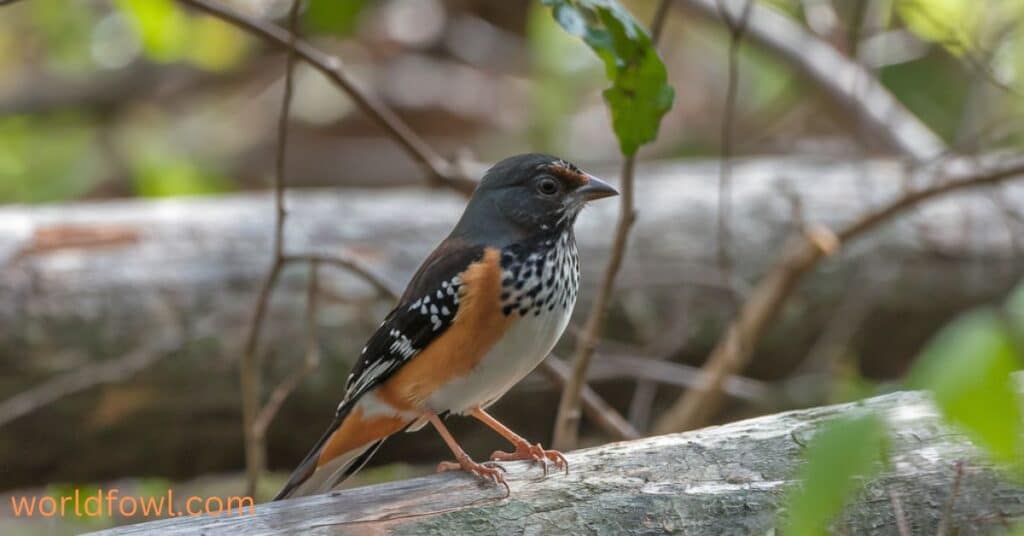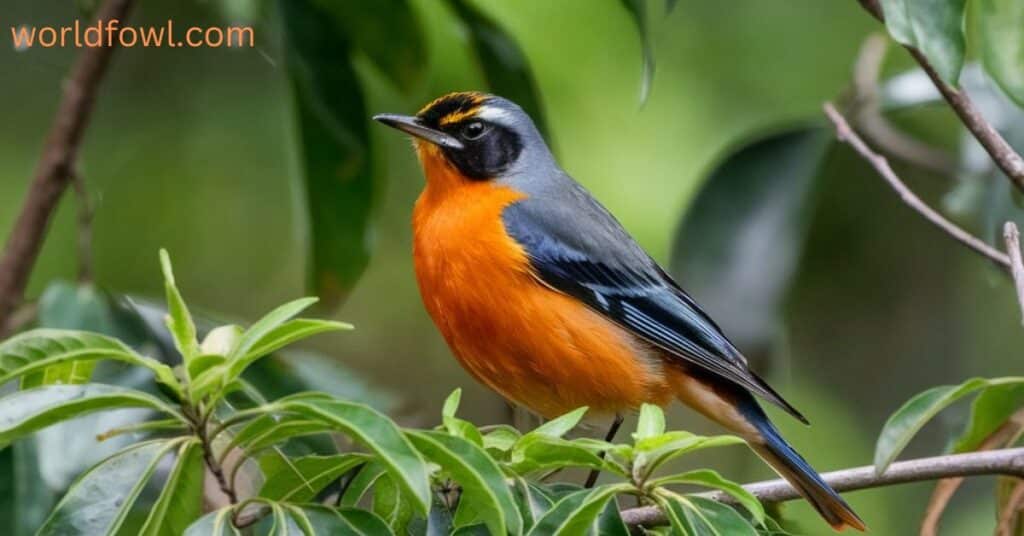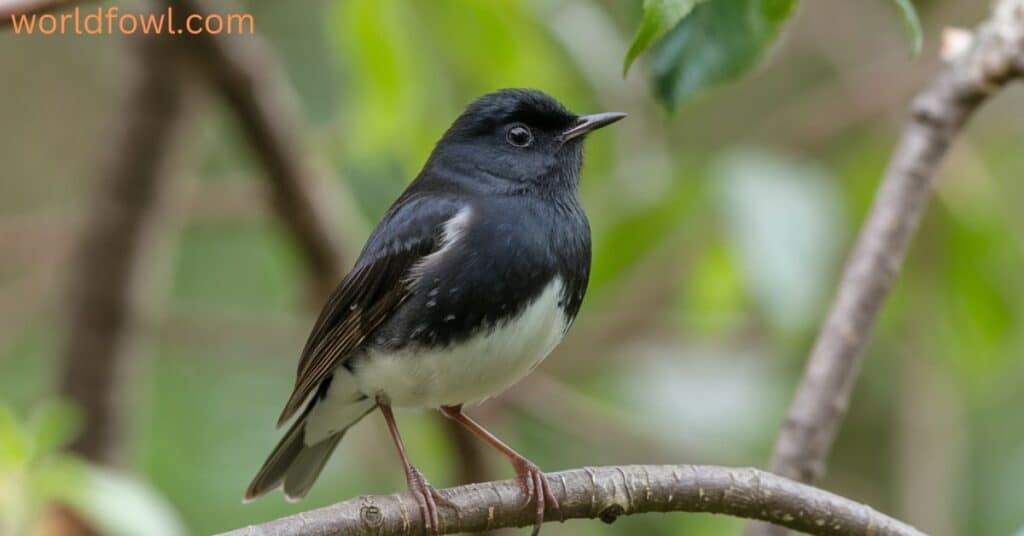In this comprehensive guide, we’ll explore nine ” Small Black Bird With White Belly ” found in North America. Each species will analyze in depth, discussing their habitats, behaviors, and identifying features. Whether you’re an amateur birdwatcher or a seasoned ornithologist, understanding the diversity of these birds will deepen your appreciation for the avian world.
Birdwatching is a favorite pastime for many, and North America provides an ideal setting for observing a variety of unique and beautiful bird species. Among the most intriguing are small black birds with white bellies. Despite ”Small Black Bird With White Belly ” modest size, these birds stand out due to the stark contrast between their dark upper plumage and bright white undersides. Not only do these birds captivate birdwatchers, but they also play vital roles in their ecosystems.
Why Do So Many Birds Have Black and White Plumage?

Black and white plumage is one of the most striking color combinations in nature, and it can found in many species across North America. But why have so many birds evolved with this particular color scheme? There are several reasons, Small Black Bird With White Belly provide survival advantages.
Camouflage in a Complex Environment
At first glance, black-and-white coloring might not seem like the most effective camouflage, but in certain environments, it works surprisingly well. In dappled light conditions, such as those found at forest edges or among dense foliage, the contrast between black and white feathers can help break up the bird’s silhouette. This makes it harder for predators to detect the bird. For example, the Black-and-white Warbler blends seamlessly into its environment as it moves up and down tree trunks, foraging for insects. The alternating patches of light and dark help it hide in plain sight.
Similarly, the Dark-eyed Junco, with its slate-gray back and white belly, can disappear into a snowy landscape, using the lightness of its belly to match the snow and the darkness of its back to blend with shadows or the gray bark of trees. This adaptation allows these birds to stay hidden from predators like hawks, owls, and other birds of prey that rely on sight to hunt.
you may also like : How To Clean A Bird Bath – Safe Bird Bath Cleaning Explained
Mimicry and Sexual Selection
In many bird species, the males use bold colors and patterns to attract mates. The stark contrast of black and white feathers can make birds more visible during courtship displays, helping males stand out to females. For instance, male American Redstarts use their flashy black-and-white plumage, combined with orange highlights, to attract mates. The white belly adds to the dramatic effect when the male spreads his wings and tail during mating displays.
Beyond mating, the pattern of black and white can also serve as a signal to other birds. In species that engage in mimicry, these visual cues can make a bird look more intimidating to rivals or potential predators. The Eastern Kingbird, for example, uses its sharp contrast to appear more aggressive when defending its territory, a trait that helps keep intruders at bay.
Thermoregulation and Efficiency
Birds with dark-colored feathers can absorb more sunlight, which helps them regulate their body temperature in cooler climates. On the other hand, white feathers reflect sunlight, preventing overheating in warmer climates. Birds like the Dark-eyed Junco, which live in colder regions, benefit from this natural design. Their darker upperparts absorb heat, while their lighter-colored bellies prevent them from getting too warm when exposed to the sun. This balance is particularly important for birds that live in variable environments, where temperature regulation is key to survival.
Black and white plumage may seem simple, but it offers a wide range of evolutionary benefits, from protection against predators to enhanced mating success and thermoregulation. These traits have helped small black birds with white bellies thrive in diverse environments across North America.
Small Black Bird With White Belly Species
Now, let’s dive into the nine small black bird species commonly found in North America that feature striking white bellies. These birds span multiple families and habitats, showcasing the diversity of black-and-white plumage in the avian world.
Flycatchers
Eastern Kingbird (Tyrannus tyrannus)

The Eastern Kingbird is a striking bird commonly found across North America during the breeding season. As one of the largest flycatchers in its range, the Eastern Kingbird is easily recognizable due to its bold black and white coloration, with dark black plumage covering its head and back and a bright white belly. Its tail is particularly distinctive, featuring a white tip that contrasts sharply with its otherwise dark tail feathers.
- Size: Roughly the size of an American Robin, but more slender.
- Habitat: The Eastern Kingbird is often found in open habitats like fields, orchards, and near water bodies. It prefers areas with scattered trees or perches from which it can hunt.
- Behavior: True to its name, the Eastern Kingbird is a fearless defender of its territory. It will aggressively chase away larger birds, including hawks and crows, when they enter its breeding area. This flycatcher is known for its distinctive habit of sitting on high perches, waiting for insects to fly by before darting out to catch them mid-air.
- Migration: This bird breeds throughout most of North America, from Canada to the southern U.S., before migrating to South America for the winter.
Eastern Kingbirds are most active during the early morning hours and can see perching on fence posts or the tops of trees. Birdwatchers can identify them not only by their distinctive appearance but also by their aggressive behavior when defending nests.
you may also like : Small Blue Bird – 8 Blue Colored Birds In North America
Black Phoebe (Sayornis nigricans)

The Black Phoebe is a small, elegant bird that frequents the western and southwestern parts of North America. Its body is primarily black, with a sharply contrasting white belly that makes it easy to identify. Unlike other flycatchers, the Black Phoebe is closely associated with water sources, making it a common sight along rivers, ponds, and coastal regions.
- Size: Slightly smaller than the Eastern Kingbird, typically around 7 inches in length.
- Habitat: The Black Phoebe prefers areas near water, such as riverbanks, lakes, and coastal cliffs. It’s especially common in California and the southwestern U.S.
- Behavior: Like other flycatchers, this bird spends a lot of time perched on low branches or rocks near water, waiting for insects to pass by. It’s easily recognizable by its habit of constantly pumping its tail while perched. The Black Phoebe feeds primarily on flying insects, making swift, acrobatic flights to catch its prey.
- Identification Tip: Its clean, crisp division of black upperparts and a white belly makes the Black Phoebe one of the easiest small birds to identify.
Because of its close association with water, the Black Phoebe can see in backyards that feature birdbaths, ponds, or other water features. This species is particularly common in California, where it thrives in a wide variety of habitats, from urban areas to remote wilderness.
Dark-eyed Junco (Junco hyemalis)

One of the most familiar birds during the winter months, the Dark-eyed Junco is a small bird that can found throughout North America. This bird is known for its slate-gray upperparts and striking white underside, which makes it a common visitor to backyard feeders during the colder months.
- Size: A small, sparrow-like bird, around 5-6 inches in length.
- Habitat: Dark-eyed Juncos breed in coniferous forests, particularly in northern and mountainous regions. During winter, they migrate to open woodlands, parks, and suburban areas across the U.S., making ”Small Black Bird With White Belly” a familiar sight in backyards during the colder months.
- Behavior: These birds forage on the ground, often seen hopping around under bird feeders or in open patches of snow. They feed on seeds and small insects, scratching through leaf litter with a characteristic double hop known as “double-scratch.”
- Migration: Many populations of Dark-eyed Juncos are migratory, moving south from Canada and the northern U.S. to spend winters as far south as Mexico. However, some populations remain in colder areas throughout the year.
Juncos are sometimes referred to as “snowbirds” because they appear in many parts of the U.S. during the winter. Their contrasting slate-gray bodies and white bellies make them easy to spot against snowy backgrounds, and their cheerful, twittering calls are a welcome sound during the colder months.
you may also like : Blue Birds In California – 22 Beautiful Blue Birds (With Photos!)
Harris’s Sparrow (Zonotrichia querula)

The Harris’s Sparrow is a large sparrow with striking black-and-white plumage. This species is known for its black bib, pinkish bill, and prominent white belly, making it a distinctive bird to identify during migration.
- Size: Larger than most sparrows, measuring up to 7-8 inches in length.
- Habitat: The Harris’s Sparrow breeds in the far northern reaches of Canada’s boreal forest but migrates through the central U.S., particularly in the Midwest. Can found in open fields, meadows, and shrubby areas during migration.
- Behavior: Unlike many sparrows, the Harris’s Sparrow is relatively easy to spot due to its large size and bold markings. These birds primarily feed on seeds and insects, foraging on the ground in groups.
- Identification Tip: The Harris’s Sparrow has a bold black cap, face, and bib, which contrasts sharply with its pinkish bill and white belly. This coloration makes it one of the most distinctive sparrows in North America.
Though it’s a rare sight for many birdwatchers, the Harris’s Sparrow is a bird worth watching for during migration, particularly in the central U.S. Its large size and striking appearance make it a favorite among sparrow enthusiasts.
Eastern Towhee (Pipilo erythrophthalmus)

The Eastern Towhee is a striking bird with a bold black back, bright white belly, and rufous flanks. This species is commonly found in the eastern U.S., where it inhabits dense shrubs and forest edges. It is known for its distinctive call, which sounds like it’s saying “drink your tea.”
- Size: Larger than sparrows, measuring 7-8 inches in length.
- Habitat: Eastern Towhees prefer habitats with thick undergrowth, such as forest edges, overgrown fields, and thickets. They are commonly found throughout the eastern and southeastern U.S.
- Behavior: These birds are often seen foraging on the ground, using a distinctive “two-footed hop” to scratch through leaf litter in search of insects, seeds, and berries. Males are particularly vocal during the breeding season, singing from perches hidden in dense vegetation.
- Their bold markings make them easy to identify when they emerge from their usual hiding places.
Though shy and often difficult to spot in thick undergrowth, the Eastern Towhee can be identified by its characteristic call and striking plumage. It is a favorite bird for those who enjoy birdwatching in the southeastern U.S.
you may also like : Backyard Small Birds In Florida – 10 Wonderful Florida Backyard Birds
Spotted Towhee (Pipilo maculatus)

The Spotted Towhee, closely related to the Eastern Towhee, is a western counterpart that features black upperparts with bold white spots and a bright white belly. Its rufous sides and distinctive spotting make it a striking bird to observe.
- Size: Similar to the Eastern Towhee, around 7-8 inches in length.
- Habitat: The Spotted Towhee is found in open woodlands, shrubby areas, and chaparral throughout the western U.S. and Canada. Like the Eastern Towhee, it prefers dense vegetation for cover and foraging.
- Behavior: This bird is a ground forager, often seen scratching in leaf litter for insects and seeds. It has a similar “two-footed hop” to its eastern cousin and is known for its loud, harsh calls.
- Identification Tip: The Spotted Towhee is distinguished from the Eastern Towhee by the bold white spots on its wings and back, as well as the black-and-white coloration of its tail. These features, combined with its rufous flanks, make it a striking bird to observe.
The Spotted Towhee is a common bird throughout the western U.S., particularly in open woodlands and areas with dense undergrowth. Its bold markings and distinctive behavior make it a favorite among birdwatchers.
Black-and-white Warbler (Mniotilta varia)

The Black-and-white Warbler is a small, energetic bird that is unique among warblers for its habit of creeping along tree trunks and branches, much like a nuthatch. This bird’s black-and-white striped plumage makes it easy to identify, even from a distance.
- Size: One of the smaller warblers, typically 5-5.5 inches in length.
- Habitat: Black-and-white Warblers breed in deciduous and mixed forests throughout the eastern U.S. and Canada. During migration, they can be found in a wide range of habitats, including parks and gardens.
- Behavior. It moves along tree trunks and branches, searching for insects hidden in the bark. Its behavior is similar to that of woodpeckers or nuthatches, but it lacks the stiff tail used by those birds to brace against tree trunks.
- Identification Tip: The Black-and-white Warbler has a unique striped appearance, with bold black-and-white streaks running along its head, back, and wings. Its belly is white, creating a striking contrast with its dark upperparts.
Birdwatchers can easily spot the Black-and-white Warbler by its distinctive foraging behavior and bold plumage. It’s a common sight during migration and is often found in wooded areas across North America.
you may also like : Black-and-white Warbler (Mniotilta varia)
Blackpoll Warbler (Setophaga striata)

The Blackpoll Warbler is a small songbird that is famous for its impressive migratory journey. This bird breeds in the boreal forests of Canada and Alaska and migrates thousands of miles to its wintering grounds in South America.
- Size: Similar in size to other small warblers, around 5-6 inches in length.
- Habitat: During the breeding season, the Blackpoll Warbler is found in coniferous forests in the far north. During migration, it can be seen in a variety of habitats, including coastal forests and scrublands.
- Behavior: The Blackpoll Warbler is known for its high-pitched, rapid song, which can be difficult for humans to hear. During migration, it undertakes an incredible journey across the Atlantic Ocean, flying non-stop for several days.
- Identification Tip: In breeding plumage, males are black and white, with a distinctive black cap and white cheeks. Their underparts are white with streaking along the sides.
The Blackpoll Warbler is one of the most impressive migratory birds in North America, capable of flying thousands of miles over open ocean. It’s a birdwatcher’s favorite, particularly during migration seasons.
American Redstart (Setophaga ruticilla)

The American Redstart is a colorful warbler known for its striking black-and-orange plumage in males, and gray-and-yellow in females. Its bold, energetic movements make it a favorite among birdwatchers.
- Size: Similar in size to other small warblers, around 5-6 inches in length.
- Habitat: The American Redstart breeds in deciduous forests across North America and migrates to Central and South America for the winter.
- Behavior: This bird is known for its flitting, energetic movements as it flashes its bright orange patches to startle insects into flight. It forages actively, often hovering to catch insects mid-air.
- Identification Tip: Males have black bodies with bright orange patches on the wings, tail, and flanks. Females are more subdued, with gray upperparts and yellow patches.
The American Redstart is a striking warbler that adds a burst of color to forests across North America. It’s especially active during the spring and fall migration seasons, when it can be seen in open woodlands and forest edges
North America is home to a wide variety of small black birds with white bellies, each species bringing something unique to the birdwatching experience. From the fearless Eastern Kingbird to the energetic American Redstart, these birds contribute to the rich biodiversity of the continent. Birdwatchers across North America can enjoy observing these birds in a range of habitats, from backyard feeders to remote forests.
Each bird on this list has evolved its own unique adaptations, from the Black Phoebe’s tail-pumping behavior to the Blackpoll Warbler’s incredible migratory feats. By learning more about these birds, you can enhance your birdwatching experience and contribute to the appreciation and conservation of these important species.

Henry James is a seasoned blogger and a passionate storyteller on “World Fowl.” With years of experience crafting engaging content, he brings a unique blend of expertise and creativity to his writing. Henry specializes in exploring diverse topics with depth and clarity, captivating readers worldwide.







